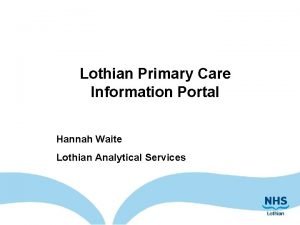NHS Lothian Primary Care Summary Guidance for the

- Slides: 1

NHS Lothian Primary Care Summary Guidance for the Investigation & Management of Hypertriglyceridaemia November 2017 A Guide to Best Practice in Lothian revised in line with 2016 updated NICE Guidelines Dr T Caparrotta, Dr S Jenks, Dr I Mac. Intyre, Dr J Malo, Prof S Maxwell, Dr E Morrison, Dr P Rae and Prof DJ Webb Triglycerides (TG) (mmol/L) Raised TG Routinely measured as part of a full lipid profile to e. g. >5 mmol/L on a random sample enable LDL calculation. TG testing in isolation is rarely indicated. Can be elevated on a non-fasting sample due to Repeat fasting lipid profile to confirm in 1 -2 weeks the presence of dietary TG, consider fasting sample. Very high TG levels e. g. >10 mmol/L are associated with pancreatitis; increased morbidity and mortality independent of CVD risk. High TG are most commonly due to secondary causes e. g. poorly controlled diabetes mellitus, alcohol excess or medications. The relationship between TG and cardiovascular risk is unclear. Overall it is felt that raised TG still confer a small degree of additional risk. If fasting TG raised at >2. 5 Assess & treat secondary causes† Give lifestyle & dietary advice* Repeat fasting lipid profile after above interventions Clinical assessment Check BP, measure weight/BMI, smoking status & alcohol intake Examine for any skin changes suggestive of a primary hyperlipidaemia Check TFTs, fasting blood glucose (click here for more information on the diagnostic work-up for diabetes), renal function, liver function, MCV and GGT † Consider any relevant secondary causes e. g. review medications Further tests as appropriate e. g. pregnancy test, urinalysis to check for proteinuria † TG 2. 5 – 4. 49 Continue to treat any secondary causes Reinforce lifestyle advice Regular TG monitoring not required Secondary causes of raised TG Alcohol excess Nephrotic syndrome/ renal disease Drugs (including thiazides, noncardioselective beta blockers, oestrogens, tamoxifen, corticosteroids) Hypothyroidism Immunoglobulin excess Bulimia Pregnancy Obesity Insulin resistance Diabetes Metabolic syndrome * Lifestyle advice Weight loss, if appropriate Reduce or abstain from alcohol Dietary modification: reduce total calorie intake by minimizing intake of fats and carbohydrate increase intake of fish, especially oily fish Smoking cessation (smoking independently increases TG levels) Increase physical activity Version: 2, Approved: ADTC ‘ 17, Review date: 11/20 TG 4. 5 – 10 Treat with a statin if at significant cardiovascular risk (based on usual criteria) If treatment is not started repeat TG in 1 month to confirm TG remain <10 TG >10 Refer to secondary care Optimise any secondary causes Consider starting a fibrate if not contraindicated During treatment Repeat fasting lipid profile & ALT in 8 weeks No specific treatment target exists for TG at present In this group the main treatment aim is to transform a highly atherogenic lipid profile with moderately raised TG, high LDL and low HDL into a less atherogenic one If TG remain > 5 on statin treatment and the patient is at high cardiovascular risk we recommend specialist advice is obtained(preferably via e-mail) Seek specialist advice If TG >10 TG 5– 10 in a high cardiovascular risk patient not responding to statin treatment Suspected familial hyperlipidaemia Patients with significant hyperlipidaemia that is proving difficult to manage in primary care Refer urgently to secondary care those with TG >20 not caused by alcohol or poor glycaemic control Clinic Specialist advice contact details Lipid Clinic, RIE. Lipid. Clinic. Advice@luht. scot. nhs. uk CVD risk clinic, WGH. Cardiovasc. Risk. Advice@luht. scot. nhs. uk Lipid clinic, SJH Tel: 01506 523 841 Lothian lipid guidelines Lothian Lipid Guidelines. pdf

